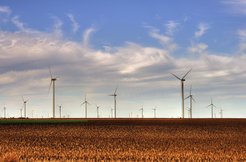Turbines weaken wind energy
Large wind farms with a high density of installed capacity slow down the wind and generate less electricity than previously thought

At the end of 2014, Germany’s wind turbines had a total installed capacity of 39 gigawatts. The German Federal Environmental Agency assumes that it would be possible to build more wind farms that would reach a total capacity of around 1,200 gigawatts, covering an area of 14 percent of Germany. These numbers correspond to 23 watts of installed capacity per square metre, and is expected to yield an output of approximately 6.7 watts of electricity per square metre. It is, however, very likely that this estimate is far too optimistic. This is the conclusion reached in a study carried out by an international team of scientists headed by Axel Kleidon, a research group leader at the Max Planck Institute for Biogeochemistry in Jena, who looked at wind energy in the windy US state of Kansas. Kansas is almost half the size of Germany and currently has around 2.7 gigawatts of installed capacity, which translates to 0.013 watts per square metre.
The researchers worked with a complex simulation model widely used in weather forecasting and for the first time included wind farms and their impacts on the wind. “When we considered only a few wind turbines, we found what we expected, that more turbines generate more electricity,” explains Lee Miller, first author of the study and a scientist at the Max Planck Institute for Biogeochemistry. “But when we considered more and more turbines, we found that wind speeds decreased and each turbine generates less electricity.”
Output per turbine declines with increasing installed capacity
As the wind would be significantly reduced if the installed capacity of the wind turbines in Kansas were to increase substantially, the generation of electricity would be limited to a maximum of 1.1 watts. This maximum energy yield is considerably lower than suggested in previous estimates, such as the one by the Federal Environment Agency, as these do not take the slowdown effect of the turbines into account.
To obtain an electricity generation rate of 1.1 watts per square metre, however, it would be necessary to have 10 watts of installed capacity per square metre. At this capacity, the turbines would only produce about ten percent of their maximum potential output. With only 0.3 watts of installed capacity per square metre, they reach 40 percent of their capacity, which is hardly reduced when the installed capacity increases to 0.6 watts per square metre. “So there is no problem deploying more wind farms in Kansas, which could yield a total of 50 times more electricity,” says Axel Kleidon.
If wind farm operators reached the limit of 1.1 watt per square metre, the resulting impacts would extend beyond reducing the yield of the turbines. “Wind is also slowed down naturally by atmospheric turbulence,” explains Axel Kleidon. “This turbulence exchanges heat and humidity between the ground and the atmosphere.” If turbulence is reduced due to the slowdown of the wind by the turbines, this would also have consequences for the climate.
Solar power generates 20 watts of electricity per square metre – with no slowdown effect
Kleidon explains the physics behind the limit on electricity generation from wind energy: the atmosphere drives the winds near the surface with surprisingly little energy. “Therefore, the more of this energy extracted by wind turbines, the greater the slowdown effect on the wind,” explains the physicist. “If the installed capacity of a wind farm does not exceed a certain level, the energy extracted from the surroundings can be replenished, particularly from above.” The smaller the total power output of a wind farm, the greater its installed density can be. “These effects result in wind turbines in large wind farms being able to generate considerably less energy than an isolated wind turbine,” says Kleidon.
The slowdown effect could also strongly reduce the wind energy potential in Germany and elsewhere. The actual value of the potential depends on the wind conditions in the specific location, which is highly favorable in Kansas. To which extent these findings apply to wind energy generation in Germany is a topic that the researchers are currently investigating. They have almost completely excluded the possibility that it could be anywhere near as high as seven watts. The electricity output from wind power is significantly lower than that generated by solar power installations. The most efficient of these yield an average of 20 watts per square metre today. In addition, there is no slowdown effect with solar power. Each additional solar panel on a roof generates the amount of electricity expected.
EF/PH












